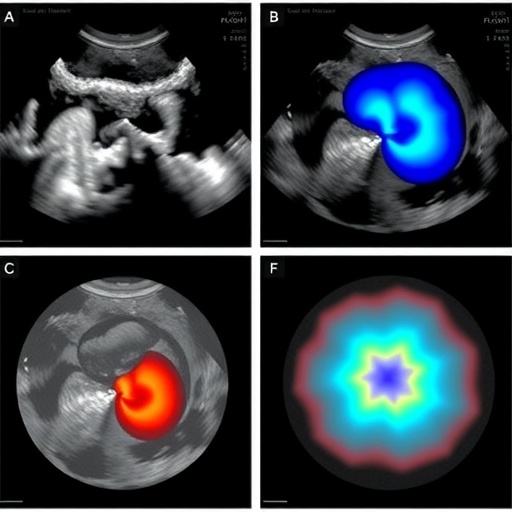In a groundbreaking study led by a team of researchers including Yang, J., Wang, M., and Zhou, D., significant advancements have been made in the field of reproductive medicine, specifically focusing on in vitro fertilization (IVF). The research investigated a novel approach utilizing three-dimensional transvaginal ultrasound algorithms to assess ovarian responsiveness, with a particular emphasis on follicular sphericity as a predictive marker. This innovative method not only enhances the understanding of ovarian function but also aims to improve clinical outcomes for women undergoing fertility treatments.
The ability to predict ovarian response accurately is vital for the success of IVF procedures. Traditionally, clinicians have relied on a variety of factors, such as hormone levels and ovarian reserve markers, to gauge how well a patient’s ovaries are likely to respond to stimulation protocols. However, these methods can sometimes lack precision, leading to suboptimal treatment plans and unexpected outcomes. The research team’s focus on follicular sphericity presents a fresh perspective that may change this paradigm.
Follicular sphericity refers to the shape and symmetry of ovarian follicles, which are fluid-filled sacs containing immature eggs. The geometrical characteristics of these follicles can provide insights into their developmental health and potential functionality. By employing advanced three-dimensional imaging techniques, the researchers were able to quantify sphericity more accurately than ever before, allowing for detailed assessments of follicular morphology. This advancement represents a significant leap in ultrasound technology applied to reproductive health.
In their study, the researchers conducted a thorough investigation involving a substantial cohort of patients undergoing IVF. Utilizing their developed algorithms, they captured high-resolution images of ovarian follicles. These images were then analyzed to determine the correlation between follicular sphericity and ovarian responsiveness. The results revealed a striking pattern: patients whose follicles exhibited optimal sphericity were more likely to respond positively to stimulation, leading to higher rates of oocyte retrieval and potentially improved pregnancy rates.
The implications of these findings are profound. By integrating sphericity analysis into routine IVF evaluation, practitioners may be able to tailor stimulation protocols more effectively. This could mean avoiding unnecessary hormone treatments for patients unlikely to respond, thereby reducing costs and minimizing the risk of side effects. Furthermore, it could enhance the overall experience for women undergoing IVF, as more personalized care could lead to more favorable outcomes and less emotional stress.
The study also examined the underlying biological mechanisms that may link follicular shape to ovarian function. It is hypothesized that the geometry of follicles may influence their ability to communicate with surrounding ovarian tissues and the ovulatory environment, impacting hormone secretion and the maturation of oocytes. By elucidating these relationships, researchers hope to gain deeper insights into female reproductive health and infertility, potentially leading to groundbreaking therapies.
As the research gained visibility, the authors emphasized the need for further validation of their findings across diverse populations. While the results are promising, they represent one step in a larger journey toward enhanced reproductive care. Future studies are needed to explore the applicability of these ultrasound algorithms in different clinical settings and to determine how they might integrate into standard practice.
Moreover, the researchers envision that the technology could evolve with advancements in artificial intelligence and machine learning, allowing for even more sophisticated analyses of follicular dynamics. The potential for automated, real-time assessments could drastically alter the landscape of reproductive medicine, making it possible for clinicians to make more informed decisions swiftly.
The quest for solutions to infertility has led to countless innovations in reproductive health, and this study marks an important milestone in that journey. By marrying technology with biology, Yang and his colleagues are paving the way for new methodologies that prioritize precision and personalization in IVF procedures. As the scientific community reflects on these findings, there is a burgeoning sense of optimism regarding the future of fertility treatments.
The researchers hope that their work will inspire other scientists and clinicians to explore uncharted territories in reproductive health, using technology as a catalyst for change. Collaboration between engineers, biologists, and reproductive specialists may uncover new avenues for enhancing fertility treatments, potentially benefiting thousands of couples facing challenges in conceiving.
In conclusion, this significant advancement in the prediction of ovarian responsiveness through the analysis of follicular sphericity highlights the intersection of technology and reproductive medicine. As research continues to evolve, the potential to refine IVF protocols and improve success rates remains an exciting prospect. This pioneering study not only showcases the capabilities of three-dimensional ultrasound algorithms but also underscores the importance of ongoing innovation in the pursuit of improved reproductive outcomes.
The findings presented by Yang, Wang, Zhou, and their team offer a glimpse into a future where fertility treatments are more effective and tailored to individual patients. As we continue to grapple with issues related to infertility globally, such research endeavors are crucial in opening new doors for hope and healing for countless families.
Subject of Research: Follicular sphericity as a predictor of ovarian responsiveness in IVF.
Article Title: Follicular sphericity based on three-dimensional transvaginal ultrasound algorithms predicts ovarian responsiveness to in vitro fertilization.
Article References: Yang, J., Wang, M., Zhou, D. et al. Follicular sphericity based on three-dimensional transvaginal ultrasound algorithms predicts ovarian responsiveness to in vitro fertilization. J Ovarian Res 18, 197 (2025). https://doi.org/10.1186/s13048-025-01771-7
Image Credits: AI Generated
DOI: 10.1186/s13048-025-01771-7
Keywords: Follicular sphericity, IVF, ovarian responsiveness, three-dimensional ultrasound, reproductive medicine.
Tags: 3D ultrasound in IVFclinical outcomes in fertility treatmentsenhancing IVF success ratesfollicular sphericity as a markerin vitro fertilization techniquesinnovative approaches to IVFovarian reserve assessment methodsovarian response predictionpredicting ovarian functionreproductive medicine advancementsthree-dimensional imaging in reproductive healthtransvaginal ultrasound technology





